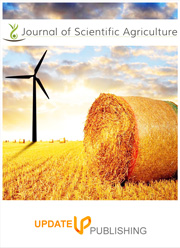AMMI Analysis for Green Pod Yield Stability of Snap Bean (Phaseolus vulgaris L.) Genotypes Evaluated in East Shewa Zone, Oromia, Ethiopia
DOI:
https://doi.org/10.25081/jsa.2022.v6.7922Keywords:
Snap bean, Genotype by Environment Interaction, Stability, AMMI, GGE BiplotAbstract
The experiment was conducted at Adami Tulu Agricultural Research Center (ATARC), Lume and Dugda Districts during the 2019 and 2020 main cropping seasons to identify adaptable and high yielder snap bean genotypes for East Shewa Zone and similar agro ecologies. Ten snap bean genotypes were used as planting material. The experiment was laid down in Randomized Complete Block Design (RCBD) with three replications. The AMMI model shows that the environment accounted for 40.93%, GXE 31.79%, and genotype 12.70% of the total variation. The high percentage of the environment indicates that the major factor influencing the yield performance of snap beans is the environment. The first two IPCAs are the most accurate model that could predict the genotype’s stability and explained by IPCA-I (53.10%) and IPCA-II (21.1%) of GEI. This result revealed that there were differential yield performances among snap bean genotypes across testing environments due to the presence of GEI. According to stability parameters (ASV, and GGE Biplot) and mean yield results revealed that G-24 and G-12 genotypes are the most stable genotypes across test locations. Therefore, G-24 and G-12 were proposed as candidate genotypes for possible release.
Downloads
References
Angela, P., Mateo, V., Gregorio, A., Francisco, R., Jose, C., & Juan, B. (2015). GEA-R (Genotype × Environment Analysis with R for Windows) Version 4.1, hdl:11529/10203, CIMMYT Research Data and Software Repository Network, V16; GEA-R_v4.1_BASE_setup.exe. Mexico.
Broughton, W. J., Hernandez, G., Blair, M., Beebe, S., Gepts, P., & Vanderleyden, J. (2003). Bean (Phaseolus spp.) – model food legumes. Plant and Soil, 252, 55-128. https://doi.org/10.1023/A:1024146710611
Ceccarelli, S. (1996). Positive interpretation of genotype by environment interaction in relation to sustainability and biodiversity. In M. Cooper & G. L. Hammer (Eds.), Plant Adaptation and Crop Improvement (pp. 467- 486), UK: CAB International Wallingford.
Crossa, J. (1990). Statistical analyses of multi-location trials. Advances in Agronomy, 44, 55-85. https://doi.org/10.1016/S0065-2113(08)60818-4
Dagnachew, L., Kassahun, T., & Girma, M. (2014). Genotype by environment interaction and grain yield stability analysis for advanced triticale (x. Triticosecalewittmack) genotypes in western Oromia, Ethiopia. Ethiopian Journal of Science, 37(1), 63-68.
Farshadfar, E. (2008). Incorporation of AMMI Stability Value and Grain Yield in a Single Non-Parametric Index (GSI) in Bread Wheat. Pakistan Journal of Biological Sciences, 11(14), 1791-1796. https://doi.org/10.3923/pjbs.2008.1791.1796
Ferreira, D. F., Demetrio, C. G. B., Manly, B. F. J., Machado, A. A., & Vencovsky, R. (2006). Statistical model in agriculture: biometrical methods for evaluating phenotypic stability in plant breeding. Cerne (Lavras), 12(4), 373-388.
Gabriel, K. R. (1971). The biplot graphic display of matrices with application to principal component analysis. Biometrika, 58(3), 453-467. https://doi.org/10.2307/2334381
Gauch, H. G. (2006). Statistical Analysis of Yield Trials by AMMI and GGE. Crop Science, 46, 1488-1500. https://doi.org/10.2135/cropsci2005.07-0193
Gauch, H. G., & Zobel, R. W. (1996). AMMI Analysis of Yield Trials. In M. S. Kang & H. G. Gauch, (Eds.), Genotype by Environment Interaction (pp. 85-122), Boca Raton: CRC Press.
Purchase, J. L., Hatting, H., & van Denventer, C. S. (1997). Genotype x environment interaction of winter wheat in South Africa: II. Stability analysis of yield performance. South African Journal of Plant and Soil, 17(3), 101-107.
SAS. (2008). Statistical Analysis Systems Institute. Version 9.1. Cary, North Carolina, USA: SAS Institute Inc.
Seyni, B., Abdoua, Y., & Sitou, L. (2017). Seed yield stability and analysis of genotype x environment interaction of sesame genotypes in central south of Niger. Journal of Animal & Plant Sciences, 34(3), 5535-5547.
Tadele, T., Behailu, M., Gashaw, S., & Amanuel, T. (2017). Genotypes by Environment Interaction of Faba Bean (Viciafaba L.) Grain Yield in the Highland of Bale Zone, Southeastern Ethiopia. Plant, 5(1), 13-17. https://doi.org/10.11648/j.plant.20170501.13
Temesgen, T., Keneni, G., Sefera, T., & Jarso, M. (2015). Yield stability and relationships among stability parameters in faba bean (Vicia faba L.) genotypes. The Crop Journal, 3(3), 258 -268. https://doi.org/10.1016/j.cj.2015.03.004
Yan, W. (2001). GGEbiplot – a Windows application for graphical analysis of multienvironment trial data and other types of two-way data. Agronomy Journal, 93(5), 1111-1118. https://doi.org/10.2134/agronj2001.9351111x
Yan, W., & Hunt, L. A. (2001). Interpretation of genotype x environment interaction for winter wheat yield in Ontario. Crop Science, 41(1), 19-25. https://doi.org/10.2135/cropsci2001.41119x
Yan, W., & Kang, M. S. (2003). GGE Biplot Analysis: A Graphical Tool for Breeders, Geneticists, and Agronomists. Boca Raton, FL: CRC Press.
Yan, W., Hunt, L. A., Sheng, Q., & Szlavnics, Z. (2000). Cultivar evaluation and mega environment investigation based on the GGE biplot. Crop Science, 40(3), 597-605. https://doi.org/10.2135/cropsci2000.403597x
Published
How to Cite
Issue
Section
Copyright (c) 2022 Temesgen Dinsa, Urgaya Balcha, Fisseha Tadesse

This work is licensed under a Creative Commons Attribution-NonCommercial-NoDerivatives 4.0 International License.



 .
.